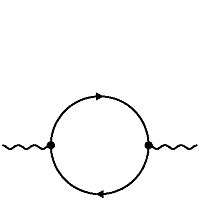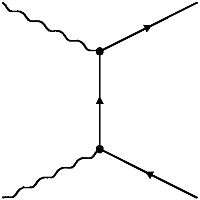Two-photon physics

Two-photon physics, also called gamma–gamma physics, is a branch of particle physics that describes the interactions between two photons. Normally, beams of light pass through each other unperturbed. Inside an optical material, and if the intensity of the beams is high enough, the beams may affect each other through a variety of non-linear effects. In pure vacuum, some weak scattering of light by light exists as well. Also, above some threshold of this center-of-mass energy of the system of the two photons, matter can be created.
Astronomy
Photon–photon scattering limits the spectrum of observed gammas to a photon energy below 80 TeV, that is, a wavelength of more than ~ 1.5×10−20 m. The other photon is one of the many photons of the cosmic microwave background. In the frame of reference where the invariant mass of the two photons is at rest, both photons are gammas with just enough energy to pair-produce an electron–positron pair.
Experiments
Two-photon physics can be studied with high-energy particle accelerators, where the accelerated particles are not the photons themselves but charged particles that will radiate photons. The most significant studies so far were performed at the Large Electron–Positron Collider (LEP) at CERN. If the transverse momentum transfer and thus the deflection is large, one or both electrons can be detected; this is called tagging. The other particles that are created in the interaction are tracked by large detectors to reconstruct the physics of the interaction.
Frequently, photon-photon interactions will be studied via ultraperipheral collisions (UPCs) of heavy ions, such as gold or lead. These are collisions in which the colliding nuclei do not touch each other; i.e., the impact parameter is larger than the sum of the radii of the nuclei. The strong interaction between the quarks composing the nuclei is thus greatly suppressed, making the weaker electromagnetic interaction much more visible. In UPCs, because the ions are heavily charged, it is possible to have two independent interactions between a single ion pair, such as production of two electron-positron pairs. UPCs are studied with the STARlight simulation code.
Light-by-light scattering can be studied using the strong electromagnetic fields of the hadrons collided at the LHC,[1] it has first been seen in 2016 by the ATLAS collaboration at the LHC.[2][3] The best previous constraint on the elastic photon–photon scattering cross section was set by PVLAS, which reported an upper limit far above the level predicted by the Standard Model.[4] Observation of a cross section larger than that predicted by the Standard Model could signify new physics such as axions, the search of which is the primary goal of PVLAS and several similar experiments.
Processes
From quantum electrodynamics it can be found that photons cannot couple directly to each other, since they carry no charge, but they can interact through higher-order processes: A photon can, within the bounds of the uncertainty principle, fluctuate into a virtual charged fermion–antifermion pair, to either of which the other photon can couple. This fermion pair can be leptons or quarks. Thus, two-photon physics experiments can be used as ways to study the photon structure, or, somewhat metaphorically, what is "inside" the photon.


We distinguish three interaction processes:
- Direct or pointlike: The photon couples directly to a quark inside the target photon.[5] If a lepton–antilepton pair is created, this process involves only quantum electrodynamics (QED), but if a quark–antiquark pair is created, it involves both QED and perturbative quantum chromodynamics (QCD).[6][7] The intrinsic quark content of the photon is described by the photon structure function, experimentally analyzed in deep-inelastic electron–photon scattering.[8][9]
- Single resolved: The quark pair of the target photon form a vector meson. The probing photon couples to a constituent of this meson.
- Double resolved: Both target and probe photon have formed a vector meson. This results in an interaction between two hadrons.
For the latter two cases, the scale of the interaction is such as the strong coupling constant is large. This is called Vector Meson Dominance (VMD) and has to be modelled in non-perturbative QCD.
See also
- Channelling radiation has been considered as a method to generate polarized high energy photon beams for gamma–gamma colliders.
- Matter creation
- Pair production
References
- ↑ D. d'Enterria, G. G. da Silveira, "Observing Light-by-Light Scattering at the Large Hadron Collider", Phys. Rev. Lett., 111 (2013) 080405
- ↑ CERN Courier: ATLAS spots light-by-light scattering
- ↑ ATLAS Collaboration: Light-by-light scattering in ultra-peripheral Pb+Pb collisions at √sNN=5.02 TeV with the ATLAS detector at the LHC
- ↑ G. Zavattini et al., "Measuring the magnetic birefringence of vacuum: the PVLAS experiment", Accepted for publication in the Proceedings of the QFEXT11 Benasque Conference,
- ↑ T.F.Walsh and P.M.Zerwas, "Two photon processes in the parton model", Phys. Lett. B44 (1973) 195.
- ↑ E.Witten, "Anomalous Cross-Section for Photon – Photon Scattering in Gauge Theories", Nucl. Phys. B120} (1977) 189.
- ↑ W.A.Bardeen and A.J.Buras, "Higher Order Asymptotic Freedom Corrections to Photon–Photon Scattering", Phys. Rev. D20 (1979) 166, [Erratum-ibid. D21 (1980) 2041].
- ↑ L3 Collaboration, Measurement of the photon structure function F2γ with the L3 detector at LEP, Phys. Lett. B 622, 249 (2005)
- ↑ R. Nisius, The photon structure from deep inelastic electron photon scattering, Physics Report 332 (2000) 165
External links
- Lauber,J A, 1997, A small tutorial in gamma–gamma Physics
- Two-photon physics at LEP
- Two-photon physics at CESR